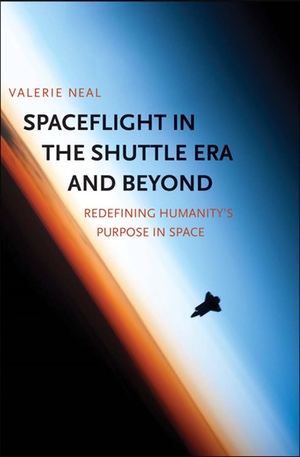Review: Spaceflight in the Shuttle Era and Beyondby Jeff Foust
|
| The original rationales during the early Space Age were tied to a race to the Moon with the Soviet Union as well as opening a new frontier, which Neal states resonated in a time when many Americans still held romantic notions of the 19th century opening of the West. |
To be fair, no one really known what NASA’s future Mars exploration missions will look like and what rovers they’ll feature; the agency has only started to sketch out on what those missions will look like. Tied to that is the question of why to go there in the first place: what is the rationale for sending humans to Mars, or elsewhere in space in general? There is no shortage of ideas, but also no consensus.
That underlying question—why should humans go into space at all—is the theme of the new book Spaceflight in the Shuttle Era and Beyond by Valerie Neal, chair of the space history department at the National Air and Space Museum. The book is, in part, a high-level history of the shuttle and space station programs, but its underlying topic is an examination of the reasons that have been developed, and altered, over time to explain why NASA should be involved in human spaceflight.
The original rationales during the early Space Age were tied to a race to the Moon with the Soviet Union as well as opening a new frontier, which Neal states resonated in a time when many Americans still held romantic notions of the 19th century opening of the West, with Westerns still popular on film and television. That changed after Apollo, as NASA changed direction to developing the shuttle, seeking to make access to space less expensive and more routine.
The shuttle was no longer opening a frontier in the same way as Apollo did, so the “imaginary” of human spaceflight—a term Neal introduces in the book from social and cultural studies to define a big, but abstract, idea explained through narratives, images and symbols—needed to change as well. Astronauts were no longer heroic figures but more anonymous figures simply doing a job. “Going to space meant going to work,” she writes. “Astronauts had jobs to do for NASA and for the shuttle’s customers.”
The astronaut corps became larger but also less famous, with a few notable exceptions like Sally Ride. Even non-career astronauts—payload specialists—got to fly, adding to the perception that spaceflight was becoming more routine. In retrospect, though, it wasn’t, as tragically demonstrated with the Challenger and Columbia accidents, as well as the shuttle’s failure to match its goals for flight rates and launch costs.
Neal traces the changing views of human spaceflight through the shuttle and station programs through NASA documents and the media, primarily in print media (broadcast and online media, she states, is voluminous enough to warrant a separate book.) Later chapters explore the various proposals for restarting human spaceflight beyond Earth orbit, starting with the mid-1980s “Pioneering the Space Frontier” report that again framed human spaceflight as part of opening a frontier.
| Will future generations, she asks, “concur that human spaceflight is in the nation’s interest and the United States should continue to lead, or will they have more pressing national priorities? Will coming generations participate in, and lead, this ongoing American tradition or step back?” |
The so-called “90-Day Report” that NASA prepared in response to the announcement of the Space Exploration Initiative in 1989 introduced the concept of exploration as a “human imperative,” she writes. The idea came “seemingly out of nowhere” and without any references for this “vaguely biological concept,” she states, but is something that has persisted in one form or another (like “exploration is in our DNA”) to this day.
Late in the book, Neal argues that the end of the shuttle program offers an opportunity to revisit the reasons for human spaceflight. The frontier rationale from the early Space Age, which persists to some degree to this day, may not be as compelling in the future as the country’s westward expansion fades further into the past and the country’s “population balance shifts” towards those who don’t find the frontier metaphor compelling. Will those future generations, she asks, “concur that human spaceflight is in the nation’s interest and the United States should continue to lead, or will they have more pressing national priorities? Will coming generations participate in, and lead, this ongoing American tradition or step back?”
Neal doesn’t have the answers to these questions, but no one really does: as the book notes, selling the American public on the value of human spaceflight has always been a challenge, even in the halcyon days of Apollo. Neal does a great job in Spaceflight in the Shuttle Era and Beyond tracing how the rationales for human spaceflight have changed over the decades, trying to link changing programs and priorities with more fundamental aspects of American society. That effort continues as NASA tries to win support for human missions to Mars and elsewhere beyond Earth orbit—with no guarantee that there is any explanation strong enough to win substantial and sustained support.
